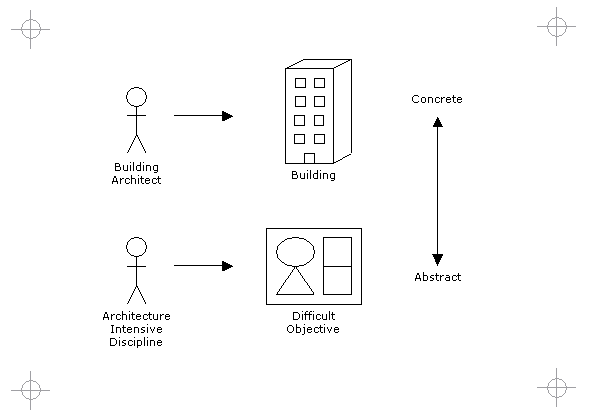|
Diagram
|
|
|

|
|
Title
|
|
|
Architecture Intensive Disciplines
|
|
Building Architecture
|
|
|
According to the Penquin Dictionary, architecture can be defined as
"a method or style of building."
An architect can be defined as a person
"who devises, plans and achieves a difficult objective."
The term
"architecture" and the role of "architect" can be used outside of building architecture. It is used extensively in information technology.
|
|
Architecture Intensive Disciplines
|
|
|
Architecture intensive disciplines in information technology include Software Architects, Enterprise Architects, Data Architects, IT Architects, Application Architects, Network Architects and System Architects. Architects can work with very tangible structures such as buildings or hardware infrastructure. Others work with organisational structures where people represent the building blocks or foundation. Architects can also work with abstract things such as ideas, information, data and software.
|
|
Case Study A: Large Corporate IT
|
|
|

|
|
|
The role of the Software Architect was introduced into the environment. Within a large organisation there are a number of different types of architectures and architects. In this large environment, all of the above architectural roles were evident in the IT department (i.e. Enterprise Architects, Network Architects, etc.). One of the most challenging aspects of architecture was aligning different approaches, identifying and unifying architects reporting in different teams or groups. There wasn't a strong culture or support for software architecture and this was evident in part through the lack of definitions, documents and diagrams.
However, a more telling sign of the lack of architecture was the lack of formal architectural skills and practices such as visual modeling, prototyping and abstracting. A contributing factor was the fact that most systems were "bought" instead of "built". The "architecture" was centered around vendor platforms such as SAP and Microsoft. The majority of staff were contractors or temporary workers which impacted on the issue of knowledge management - retention and transferral.
Some of the positions encountered did not come with a job title that included the term "Architect" but the responsibilities indicated that this was an architectural role (e.g. designing of solutions). Also there were managers who saw themselves as the architects. The practice of using the term "Architect" in job titles and descriptions was relatively new. The practice has gradually emerged or re-emerged during the period observed. An architecture team was established to support project development teams. An initiative was also started to introduce job titles to the human resource department that contained the terms "architect" and "engineer" in place of more traditional IT titles such as "developer", "analyst", "programmer" and other terms of reference such as "senior" and "junior". Mentorship and workshops were conducted to facilitate knowledge sharing and skills development.
|
|
Case Study B: Small Commercial Team
|
|
|

|
|
|
The role of the Software Architect was introduced formally into the environment for the first time. Because of the nature of a small team, architecture intensive skills were identified at a more personal level - as a knowledge issue. Certain tasks were deemed as more "architectural" than others. The architecture was encouraged as a team responsibility - incorporated into multiple roles.
|
|
|